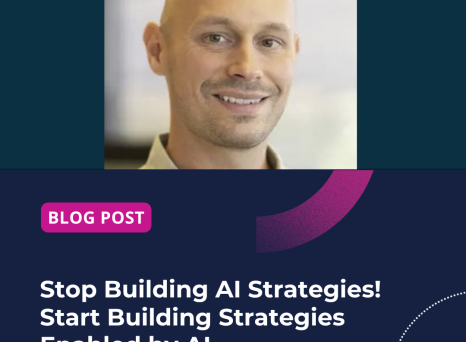According to Gartner, by 2030, 80% of project management tasks will use AI, big data, machine learning (ML), and natural language processing. This will result in increased support for the Project Management Office (PMO) function, as organizations will be able to transform how PMOs operate.
For example, PMOs could automate everything from risk assessments to stakeholder analysis. They could also automate report preparation and feedback gathering and make process compliance easier with tools for monitoring.
Indeed, with AI and ML enhancing their tools and processes, PMOs can boost efficiencies in countless ways. In this article, we look at our top 10 practical use cases.
1. Accurate Forecasting for Faster Delivery
Every time you create a budget for your project, you should create a margin of error that accounts for unforeseen costs. But because your budget is simply an estimate, sometimes you can spend more than this buffer allows.
However, with AI you’re using historical data to identify the most likely cost and time slippages. You then use predictive analytics to project actual completion dates and costs. This means both your budget and your margin of error are more accurate and reliable.
This will have a knock-on effect regarding efficiencies across your portfolio. For instance, as your forecasted deadlines will be more accurate, you will release your teams in time for their next project. This will allow you to see the results of projects faster, accelerating timelines for ROI and increasing revenue.
And consider the time savings when it comes to the act of forecasting itself. By using algorithms, you can dramatically cut down the time it takes to calculate outcomes. And free up your teams’ time to focus on tasks more worthy of their skills.
2. Risk Management and Mitigation
AI and ML-enhanced data analytics tools can scan your entire project portfolio and identify projects most at risk. And, on a project-by-project basis, it can run simulations and flag overruns that you might not spot if you relied on manual analysis.
You can implement a robust mitigation plan. To put this into context, imagine you have a convergence point in your upcoming project. But, the team responsible for completing one of the necessary deliverables is short-handed. As such, they may find it challenging to work at the pace required to deliver alongside the other team.
Using a data analytics tool, you’ll know about this in good time, long before the project kicks off. You can then start developing responses to this particular risk, such as:
- Identifying resources, either internal or external, who could be temporarily available to help get the deliverable over the line.
- Extending the deadline for both project teams so that it’s more achievable.
Of course, this also ties in with capacity planning and building—which brings us to our next point.
3. Resource Allocation and Capacity Planning
An AI tool could take an overarching view of your workforce, facilities, and supplies—what’s currently in use and what you’ve earmarked for the future. You can feed it multiple data sets around project and staff schedules, as well as each project's budget and each resource's cost.
From this, the tool could pinpoint the resources available for your upcoming projects. It would also be able to identify ahead of time if there will be a chance of resource shortages due to their unavailability or because you currently lack the budget to secure them.
You can then go away and develop a plan to overcome these issues. If, for example, you have two senior project team members on leave simultaneously, you may want to reorganize project deadlines to allow for their absence. Or, if you don’t have the budget to get the necessary materials, you can talk to stakeholders and try to convince them to loosen the purse strings.
4. Identifying the Right Roles and Skills
Take a look at your upcoming projects. At first glance, can you see the skills and people you need to complete every deliverable?
With AI you can feed in project data concerning tasks to identify the roles you need within your company. You can then build an algorithm to predict if you have the specific skills necessary, both hard and soft, for every task.
More than this, it can highlight the team members with these skills. It can even identify team members with adjacent skills so you can upskill them to meet your demands.
The benefits of this are threefold:
- You use your teams’ time efficiently
- You have the right skills ahead of each project
- You help your teams develop, which keeps them more engaged
5. Assigning User Stories
A user story takes the viewpoint of a specific user and explains in plain language what they want to achieve using the product. i.e. as a [description of user], I want [functionality] so that [benefit]. So, for example, one user story might be, “As a project management officer, I want a centralized hub to view all project documents in one place.”
The above example would be easy for you to come up with off the top of your head. But to write all user stories for each and every stakeholder, you’d need an in-depth understanding of their pain points and goals.
An AI-enhanced tool has the potential to identify not only each user’s role but also their challenges and objectives. Then, using NLP, it can write concise user stories. Furthermore, it will be able to assess which stakeholders have the skills relevant to each one and assign them accordingly.
6. Improving Quality of Outcomes
AI and ML-enhanced tools can help you identify projects that better meet your strategic goals and are more likely to produce results that drive business growth. Take, for example, Atomwise. Using AI technology based on convolutional neural networks, this pharmaceutical company can screen trillions of compounds. This means it’s able to identify opportunities for drug discovery quickly. As a result, it has helped tackle such serious conditions as Ebola and Multiple Sclerosis.
Atomwise also uses its scientists’ time to ensure the robustness of its data sets and to evolve its algorithms using machine learning (rather than scouring compounds). This means as the company becomes more mature, it stands even more chance of project success.
7. Improving the Customer Experience
Chatbots used to rely on rigid rules and scripted answers that could send users in a circle. But now, with AI and advances in Natural Language Processing (NLP), these virtual assistants can interact more naturally and ultimately more productively.
This enhances the customer experience for anyone experiencing an issue with their product or service or someone who needs a quick query answered. But it also means that chatbots can help users in previously unthinkable ways.
For example, you can repurpose the chatbot’s logic to serve as an always-on assistant for user onboarding, guided tours of screens, or tool tips. This will help with data quality, which depends on users understanding the importance of the data they enter.
As such, AI and NLP-enhanced chatbots not only improve the quality of service users receive—they also help you better identify further ways you can improve the customer experience.
8. Leveraging Data to Identify Driving Trends
AI has the potential to spot emerging trends that could impact your project outcome. And if you identify these in plenty of time, you could even account for them in your business case so stakeholders are aware of the possible risks.
Take, for instance, the multiple marketplace issues with semiconductors a couple of years ago. Companies using an AI-enhanced project management tool would have expected the perfect storm that arrived due to a combination of shrunk output and stockpiling at the height of the pandemic. They would have been able to respond more agilely than those without this visibility, perhaps by changing to a design that didn’t rely so heavily on the missing components.
And then there’s the flip side. Organizations that leverage data from market trends can also identify spikes of interest in the marketplace, interest that they could exploit in new projects. They can use a PM tool to assess how this pivot will affect costs (things like re-training staff and finding new suppliers). And if the ROI is still worthwhile—and the project aligns with their strategic goals—then it’s worth exploring further.
9. Automated Workflows
As you well know, just because you’ve completed the project doesn’t mean you’ve finished work on it. You and your teams will still have actions to take in the aftermath of each project. But, these follow-ups will differ depending on the stakeholders involved and the type of project in question.
As such, project follow-ups are something you can only standardize up to a certain point. What you can do, however, with the help of AI and ML, is assess past behaviors within the project and tailor actions for the aftermath. And, to make it even easier, automate workflows that will remind you of what steps to take.
This will mean that you can take the specifics of each project into account, even while juggling multiple projects.
10. Predicting Client Satisfaction Based on Previous Results
Take a look back at your previous projects. How did they perform? Were your stakeholders—and your clients—happy with the results?
If you’ve logged feedback in your AI-enhanced project management tool, it will be able to see correlations between your client responses and your teams’ actions. It will then take this data and break down your actions in your current project, and gauge your client’s satisfaction.
Then, if you identify a possibility of dissatisfaction, you can up the ante. If there’s been an oversight, you can set teams on the right course. You can also contact the client so they know you value their engagement.
But if things are progressing as they should, it’s also an excellent opportunity to chat. You could ask them to complete a survey or leave a review, so you can pursue more business.
Leverage Tools That Supercharge Your PMO
AI and ML can give you a high-level view of your entire portfolio. It can help you drill down into each project, deliverable, and task and assess what’s going right and wrong.
Essentially, AI and ML-enhanced tools can improve most aspects of your project management. And with more intelligent analytics and better data models, you can make better predictions on how your projects will perform in the future. So you can pivot and pursue those more promising projects in plenty of time.


